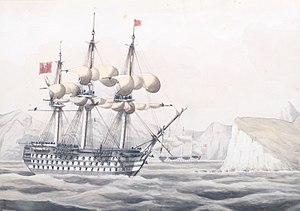
Back Britannia (Schiff, 1823) German اچاماس بریتانیا (۱۸۲۰) Persian HMS Britannia (1820) Finnish HMS Britannia (1820) French HMS Britannia (1820) Italian HMS Britannia (1820) Russian
 Watercolor of HMS Britannia, c. 1834, by John H. Wilson
| |
| History | |
|---|---|
| Name | HMS Britannia |
| Ordered | 6 November 1812 |
| Builder | Devonport Dockyard |
| Laid down | December 1813 |
| Launched | 20 October 1820 |
| Fate | Broken up, 1869 |
| General characteristics as built[1] | |
| Class and type | Caledonia-class ship of the line |
| Tons burthen | 2616 bm |
| Length | 205 ft (62 m) (gundeck) |
| Beam | 53 ft 6 in (16.31 m) |
| Depth of hold | 23 ft 2 in (7.06 m) |
| Propulsion | Sails |
| Sail plan | Full-rigged ship |
| Armament |
|
| General characteristics after 1839 | |
| Armament |
|
HMS Britannia was a 120-gun first-rate ship-of-the-line of the Royal Navy, laid down in 1813 and launched on 20 October 1820.[1]

Commissioned in 1823, she saw service in the Mediterranean from 1830-1 and in 1841. She was decommissioned in 1843,[citation needed] before returning to service for the Crimean War, serving as flagship of Admiral Sir James Deans Dundas,[2] commanding the British fleet in the Mediterranean and Black Sea from 1851–4.[citation needed].

She was engaged in the Bombardment of Sebastopol on 17 October 1854 during the Crimean War.[3] On 14 November 1854, she was driven ashore on the Russian coast and was reported to have 5 feet (1.5 m) of water in her hold.[2]
She returned to England at the beginning of 1855 and that year became a hospital ship at Portsmouth, then a cadet training ship in 1859.[1] She was moved to Portland in 1862, then Dartmouth in 1863, where she served as residential barracks for cadets.
She was finally sold for breaking up in 1869.[1] Her place at Dartmouth was taken by HMS Prince of Wales, which was renamed Britannia for the role.
Generations of naval officers had their first taste of the navy aboard the two Britannias. Alumni included John Fisher, Percy Scott, John Jellicoe, Roger Keyes, William Boyle, Augustus Agar and King George V.